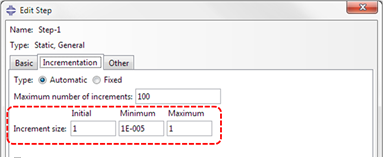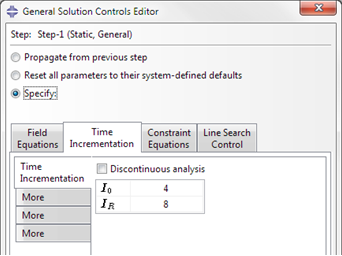Modify the time incrementation parameters to take full advantage of Simulation Composite Analysis.
Simulation Composite Analysis significantly improves the overall convergence rate and robustness of progressive failure simulations of composite structures. However, in order to take full advantage of its superior convergence characteristics, you must change some of the default settings that govern the nonlinear solution process used by Abaqus/Standard. This section discusses the use of Abaqus/CAE to make the recommended changes. The information contained in this section does not apply to Abaqus/Explicit.
It is recommended that you specify the time incrementation parameters that are desired in the progressive failure analysis. Since the use of this product provides more robust convergence, it is anticipated that the progressive failure analysis will require far fewer time incrementation reductions (or cut-backs) than would be possible without the software. This characteristic may influence your choice of time incrementation parameters. These parameters can be specified from the Incrementation Tab in the Edit Step dialog box as shown below. There are four settings that can be changed: the maximum allowable number of time increments, the value of the initial time increment, the minimum allowable value of a time increment, and the maximum allowable value of a time increment.
For analyses that use Simulation Composite Analysis cohesive materials, the Extrapolation parameter should be set to None. This can be set from the "Other" tab in the Edit Step dialog.

You should also change some of the default settings that control the nonlinear solution process employed by Abaqus/Standard. These solution control parameters can be changed in the General Solution Controls Editor dialog box. The dialog box is accessed from the Step module by clicking from the main toolbar. The General Solution Controls Editor dialog box is shown below with the Time Integration Tab selected. There are two parameters shown with their default values (Io =4 and IR =8). Both of these parameters should be set to the same large value, say 1000 (e.g., Io =1000 and IR =1000).
After specifying the values of Io and IR , click the first of the three tabs that are labeled 'more'. From the list of parameters that appears, the values of IP ,IC , IL, and IS should each be set to 1000, and the value of I T should be set to 10. The greatly increased values of Io, IR, IP, IC, IL, and IS will ensure that Abaqus/Standard can take full advantage of the improved convergence characteristics provided by Simulation Composite Analysis. For a complete discussion of the effect that Simulation Composite Analysis exerts on the convergence behavior of the finite element solution, see the Convergence Issues for Progressive Failure Analyses section of the Theory Manual.
Contact and Erroneous Failure
When contact is included in an analysis with Simulation Composite Analysis, the above set of solution controls may produce erroneous failure predictions when the contact is being initially established. As such, it is recommended that the initial contact is established in a separate step that does not include the above solution controls.
